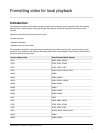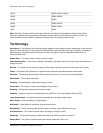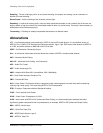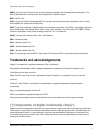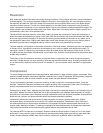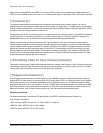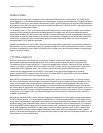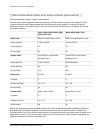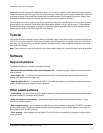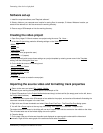
Formatting video for local playback
Generated by Clearspace on 2008-05-18-05:00
7
Audio codec
Advanced Audio Coding (AAC) compression has a standard profile known as Low Complexity, or LCAAC. As the
name suggests it is a computationally cheap form of compression, requiring little processor time. Originally designed
for the MPEG-2 format as a more efficient replacement for MP3, it offers higher sound quality than MP3 compression
at the same bit rate. AAC also offers a second profile called High Efficiency, HE-AAC, or AAC+, that further improves
sound quality at bitrates below 64kbps.
For multimedia video, LC-AAC is the recommended AAC profile to use. Its low processor utilisation and consistent
processor load at constant bit rates allows processing power to be better spent on the more demanding task of
video stream decoding. HE-AAC can be used, but due to the extra complexity involved, video playback can often be
compromised in terms of fluidity and loss of A/V stream synchronisation. Although this can be resolved by reducing
video bit rate, for often zero gain in overall audio quality the overall video quality suffers due to the inconsistent
processing load HE-AAC decoding generates.
Several implementations of the LC-AAC codec exist, with varying levels of optimisation and performance offered at
equal bitrates. For most multimedia content, any standards compliant LC-AAC implementation is sufficient. However,
all content, and especially music videos, will benefit from the higher quality audio encoding offered by the optimised
Apple or Nero AAC codecs.
{*}Video codec{*}
MPEG-4 video streams come under two visual profiles; Simple and Advanced Simple. Simple is designed for
low bandwidth applications and portable devices. Sony Ericsson phones support the simple visual profile only.
The simple profile has 4 levels defined for it. These levels suggest video resolution, frame rate, bit rate, and other
values. If you adhere to the strict definition of these levels, Sony Ericsson phones only support level 0. With some
customisation of the suggested values, Sony Ericsson phones can also support modified levels up to level 3.
There are many implementations of the MPEG-4 visual codec, with quite extreme differences in encoding
quality. Available MPEG-4 codecs include DivX, XviD, 3ivx, Apple MPEG-4, Nero MPEG-4, and many standard
implementations found in various video editing software.
Many MPEG-4 implementations offer the choice of single pass (1 pass) or 2 pass encoding. In 2 pass encodings,
the source video stream to be transcoded is read twice, using the first pass to inspect the overall complexity of the
video, and the encoder then assigns a higher bit rate to the more visually complex passages of the video on the
second pass, and lower bitrates to simple passages. In 2 pass encodings use of available bit rate is more efficient,
but it often results in the encoder using a higher bit rate on some passages than mobile phones support. As such you
should ensure any MPEG-4 codec is using single pass mode when you encode a video stream. The one exception
to that rule is if your target bit rate is well below the optimal value for the phone, as sufficient bit rate overhead is
available in that instance.
Although any standard MPEG-4 visual codec that supports the simple profile can be used to encode video streams
for Sony Ericsson phones, it is not advisable for optimal results. The recommended MPEG\- 4 visual codec is XviD,
a very mature implementation with specific optimisations for low bitrate encoding in the simple visual profile. It offers
significant quality gains compared to other codecs in low bitrate applications such as mobile phones. It is important
to note that MPEG-4 video support on Sony Ericsson phones is only supported in the simple profile. A great deal of
online video content also uses MPEG-4 video codecs, such as the above mentioned XviD, or DivX. However they
will likely be MPEG-4 video encoded using the advanced simple profile, which is unsupported on Sony Ericsson
phones. This means that although they may share the same codec they will need to be transcoded to MPEG-4 in the
simple profile, for use on mobile phones.



